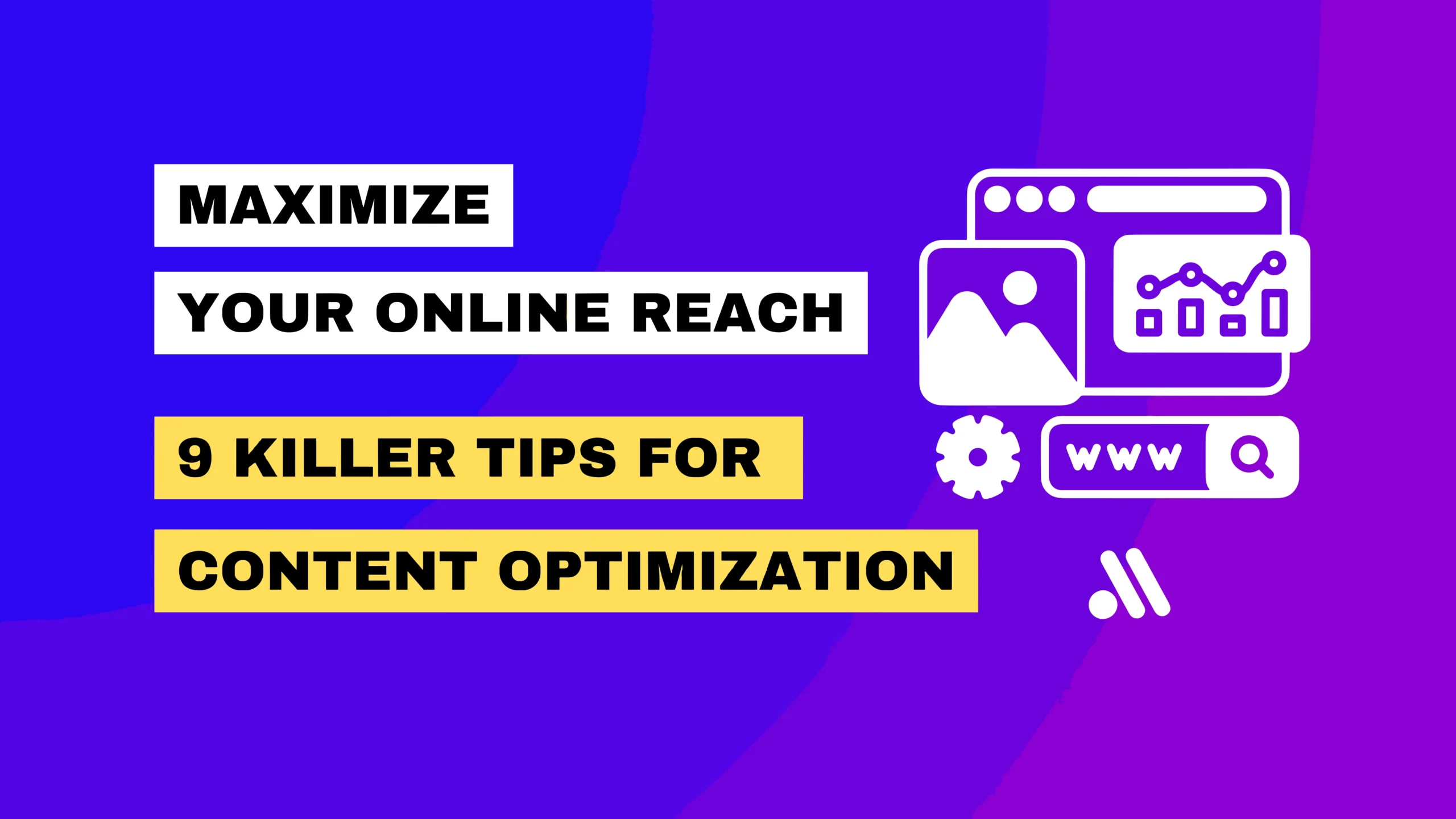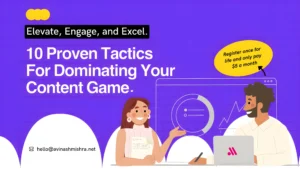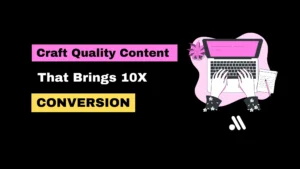Have you ever googled something related to your business or industry and struggled to find your own website on the first page of search results? Most businesses have an online visibility problem that’s hurting their bottom line.
The solution is Strategic Content Optimization.
Content optimization, also known as search engine optimization (SEO), allows you to improve your website’s authority and relevance in the eyes of search engines. The higher your pages rank in search engines, the more traffic leads, and sales you’ll generate.
However effective SEO requires an understanding of how search algorithms have evolved. Simply stuffing keywords into your content won’t cut it anymore.
In this comprehensive guide, you’ll learn actionable tips and strategies to optimize your website content for higher rankings and more traffic.
The Importance of Being Visible Online
Your website is often the first touchpoint between your business and potential new customers. If your site doesn’t show up prominently in search results for relevant keywords, you’re missing out on quality traffic and visibility.
“Online Visibility Is The Superpower In The Business World of Clicks And Searches.”
Consider these statistics:
72% of consumers who did a local search on their smartphone visited a store within 5 miles. (BrightLocal)
53% of website traffic comes from organic search. (Ahrefs)
The top 5 organic results get 67.6% of all clicks. (Advanced Web Rankings)
75% of users never scroll past the first page of search results. (Jumpshot)
It’s clear that if your content isn’t optimized for search, you’ll struggle to attract visitors in a competitive market.
But when your pages consistently rank high organically, you can expect:
Increased site traffic and lower cost per lead.
More leads and sales at a higher conversion rate.
Improved brand visibility, trust, and authority.
Better customer retention over the long-term.
Integrate search engine optimization (SEO) into your digital strategy for substantial organic growth and increased revenues.
Grow your online presence and profits with this essential focus.
What Is Content Optimization?
Content optimization refers to the practice of optimizing online content to rank better in search engines like Google and Bing.
The goal is to help search bots correctly index and understand your content, so it appears more relevant for related keyword searches made by your audience.
This allows you to “earn” higher organic rankings so more of your ideal customers can find and engage with your website.
“Content Is Not Just The King, It's the superhero that search engines rely on for relevance”
Unlike paid search ads, you don’t have to pay every time someone clicks on your link in search results. The higher your pages rank for valuable keywords, the more free organic traffic you’ll get over the long run.
Properly optimized content not only helps you rank well initially but keeps you ranking high by providing an excellent user experience.
Core Principles of Effective Content Optimization
Modern search engine algorithms are incredibly advanced. Google uses machine learning and AI to analyze countless signals that determine the relevance of a page.
While the exact ranking factors are proprietary secrets, we know content optimization boils down to a few core best practices:
1. Create Content For People First
Google values pages that are designed to help users, not just rank well. Before optimizing anything, focus on creating high-quality content that solves your audience’s problems.
Useful, engaging content written for humans is far more likely to rank well than content stuffed with keywords.
2. Optimize For Voice Search and Mobile Users
Over 50% of searches now happen on mobile devices. And a quarter of those are conducted by voice commands rather than typing.
To adapt, create content in conversational language and use natural phrases people would say or ask. Optimize page speed and UI for smaller screens.
3. Earn Links and Social Signals
Search engines consider external signals like backlinks and social media shares to gauge popularity and authority. Earning backlinks from reputable sites is especially influential for SEO.
Outreach, guest posting, social promotion, and link inserts can all help you build natural links at scale.
4. Improve Site Architecture
Logical URL structures, effective internal linking, and easy site navigation help search bots crawl and index your site properly.
Ensure your information architecture facilitates discovery.
5. Obsess Over Relevance
At its core, SEO is about making your content highly relevant for specific keyword themes and related searches. Carefully curated keywords need to appear naturally throughout each page.
6. Build Authority and Trust
Domain authority and page authority pass “trust” signals between your content and search engines.
Publishing authoritative content on a reputable site is hugely impactful for rankings.
7. Enhance for On-Page SEO
Proper technical SEO optimization improves search visibility and bot crawling. Meta descriptions, alt text, page speed, schema markup, caching, and more all help your cause.
If you can nail these core principles, your content will be extremely discoverable and engaging for your audience.
Let’s look at specific content optimization tips and tactics to implement.
9 Actionable Tips For Content Optimization
SEO can seem overwhelming for beginners. But it’s much more straightforward when you focus on a step-by-step process.
Let me share 9 proven best practices for optimizing your website content:
1. Perform Keyword Research
Keyword research lays the foundation for any content optimization effort. You need to know exactly what phrases and questions your audience is asking about your products, services, and industry.
Common keyword research tools include:
Google Keyword Planner.
SEMRush.
Ahrefs.
Moz Keyword Explorer.
Analyze keyword search volume, competition levels, and commercial intent to identify the best opportunities. Organize keywords into relevant topic groups to guide your content structure.
Pay attention to long-tail variations around core keywords for easier ranking potential. For example, “content optimization tips” rather than just “content optimization”.
2. Audit Your Existing Content
Conduct an audit of your current website content to spot optimization opportunities.
Look for:
Pages that rank poorly for core keywords.
Thin content that needs to be fleshed out.
Pages with technical SEO issues.
Broken links that need fixing.
Address any problems through content updates, expansion, reorganization, or other improvements.
3. Create Optimized Content Pillars
Develop key content pillars, like guides or resources pages, that target your most valuable keywords and topics. These pillars will become the cornerstones of your optimization strategy.
All other content should link back to these pillars to pass link equity and anchor text. Content clustering helps search bots discover your most important pages.
4. Follow An SEO Content Outline
Creating optimized content is much easier when you follow a repeatable outline:
Feature the target keyword in the title and URL.
Include semantic variations in the H2 and H3 headers.
Introduce keywords early in the first paragraph.
Use keywords in image file names and alt text.
- Link out to authority sources to earn backlinks.
- Insert related keywords throughout naturally.
- End with a relevant call to action.
5. Optimize for Voice Search
Voice search optimization is gaining importance. Make content conversational using natural language, common questions, and long-tail phrases.
Imagine how a user would ask for your content, and then match that style.
Use tools like Answer the Public for inspiration around voice and conversational keywords.
6. Improve PageSpeed Insights Scores
Page speed significantly impacts mobile user experience and SEO. Google wants websites to load quickly.
- Reduce redirects
Compress images.
- Minify CSS/JS files.
- Optimize web fonts.
Enable browser caching.
Asynchronously load non-critical files
Test your scores with Google PageSpeed Insights and make optimizations until you reach at least 90/100 on mobile and desktop.
7. Include Optimized Media
Images, video, and other media make content more engaging while improving SEO.
Optimize your visual assets by:
- Writing detailed alt-text descriptions.
Compressing files to improve load times.
- Adding strong file names with keywords.
- Embedding videos from YouTube or Vimeo.
- Including transcript files for video and audio.
8. Promote Content Offsite
You can’t rely on SEO alone. Actively promote new content through social media, email newsletters, PR outreach, etc. to drive initial traffic.
Look for link insertion opportunities by guest posting on industry blogs. Curate and share content within your niche community.
9. Continuously Improve and Refresh
SEO is never “one and done”. Monitor your rankings and traffic regularly for trend analysis. Keep improving pages based on what competitors are doing.
Google also loves fresh, updated content. Don’t let your content get stale. Replace or renew underperforming pages.
Common SEO Content Optimization Mistakes
As you optimize your website, beware of these common mistakes:
- Over-optimizing for keyword density at the expense of readability
- Chasing short-term wins instead of long-term authority
- Prioritizing keywords over user experience
- Not promoting your content socially
- Creating “thin content” just for SEO
- Ignoring voice search optimization
- Failing to actively monitor rankings
- Stuffing in keywords forcefully
Avoid tactics like low-quality guest posts, paid links, or keyword stuffing that can trigger Google penalties.
Focus on high-value content and promotion to earn organic results that last.
Tools To Improve Your SEO Content Process
The right tools make content optimization much easier:
RankMath – All-in-one WordPress plugin for SEO.
- Frase – Content research and keyword tracking.
- BuzzSumo – Analyze high-performing competitor content.
- Clickflow – SEO content auditing across your site.
- Screaming Frog – Spider and audit technical SEO factors.
- Semrush – Backlink analysis, rank tracking, and site audits.
Invest in tools that fit your strategy to work smarter and get results faster.
Write Your Success Story In Search By Making Content Optimization Your Signature Move.
Content optimization is important for any business that wants to be discovered online.
While search algorithms are complex, you now have a solid SEO content optimization framework to follow.
Focus on creating high-quality content that anticipates searcher needs. Then incorporate targeted keywords and optimize for technical factors.
Promote your content consistently on and off your website. Measure rankings and refine your strategy over time.
- Build authority in your niche.
- Drive qualified traffic to your site.
- Boost more conversions and revenue.
It’s about achieving compounded results.
Achieving success with quality content requires time, dedication, and content optimization. But the payoff is significant.
So, go ahead and dive into creating content that genuinely supports and captivates your audience.
Till Next Post,
Stay Happy and Keep Growing! 😊🌱








